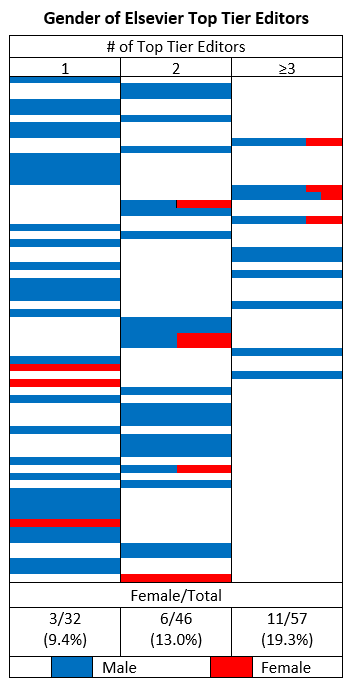The dominant publisher of economics journals suffers from a dearth of women among its top tier editors. The underlying problem is that academics are not making the selections; rather, the choices are made by Elsevier staff who do not read the journals they manage or appreciate how those journals distinguish themselves. They thus rely on superficial criteria and succumb to subjective biases on gender in picking editors.
 |
|
Sample of 65 journals drawn from the RePEc top 200. Spreadsheet here. |
The chart at left tells of the consequences. The 65 Elsevier journals captured rank within the top 200 journals according to the RePEc 10-year simple impact factor. Among these, 32 have a single editor-in-chief, three of whom are women. The highest ranking journal edited by a female editor-in-chief is Renewable and Sustainable Energy, ranked at #118 by RePEc and #18 among those Elsevier journals with one top tier editor. The other journals with sole female editors-in-chief are Economics of Education Review (#127) and Tourism Management (#173).
Females have been able to get to the top editorial tier for higher ranking Elsevier journals by teaming up with males. A female co-edits the Journal of Econometrics (#52) with one male partner, and a number of females serve at the top tier in board structures with three or more co-editors at the helm. Women achieve some of the largest shares within the largest groups, for example, four of 11 top tier editors at the Journal of Health Economics (#61) and four of 13 at Research Policy (#48). In a standout case, a team of two females co-edits Explorations in Economic History (#199).
I served as the editor-in-chief of the Journal of Asian Economics (#169) until my recent ouster by Elsevier (recounted here) ... to be replaced by a male. In my case the initial appointment was not made by Elsevier but rather by the American Committee on Asian Economic Studies which founded the journal and controlled all editorial appointments until Elsevier severed the relationship in April 2020.
Given my admittedly nontraditional but nevertheless well-suited background, I was an inspired choice for editor, so much so that when I heard the words "against all norms" spoken by Esther Duflo to describe her own employment experience (press conference, 11:20), it resonated deeply with me. Duflo was referring to her hiring by the university that trained her in accommodation of her marriage to a faculty member. As the couple had just been awared a Nobel Prize, MIT has no doubt been very happy with its bold hiring decision. So too were the stakeholders of the Journal of Asian Economics happy with me as the choice of editor. This is attested to by the 43 statements sent to Elsevier in support of my continuing in the position. The academic stakeholders judged me on the substance of my work on the journal, and on nothing else.
By contrast, Elsevier staff were pointed in their derision of my general scholarship, or rather lack thereof as they saw it. They held to a narrow ideal of what the CV of an editor-in-chief should look like and were blind to the special skillset I brought to a unique sort of journal. My deviation from the CV ideal is partly related to gender in that I left a tenured professorship to follow a husband in his career move and then raised a child on my own after the marriage ended. If there is not space for such fullness of life on the way to becoming a journal editor, many women will be shut out. In my case, however, the typical female diversions are only part of what set me on a different course. Fresh out of graduate school, I got the dream job for a China specialist at the University of Hawaii. Yet soon after our arrival, looking out over the Pacific Ocean from our balcony, my then-husband remarked, "It's too bad we got here at such a young age because it would be tempting to just stay." Indeed so, although we managed to extricate ourselves from that fate. I got the life of adventure I was meant to have, winding through Asia and through rich and varied work in academia and consulting with many rewarding collaborations along the way. Ultimately, all of this experience informed my editorial work with the Journal of Asian Economics. That was abundantly clear to the journal's academic stakeholders, but lost on Elsevier staff.
Recently, Elsevier has posted an announcement on its journal home pages extolling its "support of equality, inclusion & diversity" and promising to "redouble our deep commitment to inclusion and diversity within our editorial, author and reviewer networks." Nice sounding sentiments. But if the approach is simply to rack up tally marks on women and minorities, the academic community will not be well served. Rather, the key is to find the right people for the job, and those will not necessarily be the people with the most articles published or the positions at the highest ranking universities. Yet these superficial markers are what Elsevier staff must fall back on when they lack expertise in the subject matter of the journals they manage and are unable to comprehend the substantive contributions that editors make. Unfortunately, by these markers they end up choosing mostly men.
A great way to tap into the needed expertise is to partner with academic societies and involve them in the editor selection process. Such an arrangement was in place for 30 years for the Journal of Asian Economics with the American Committee on Asian Economic Studies. Sad to say, Elsevier unilaterally ended that relationship.
________________________
Previous posts in this series:
When you subscribe to the blog, we will send you an e-mail when there are new updates on the site so you wouldn't miss them.